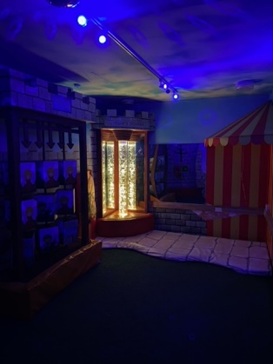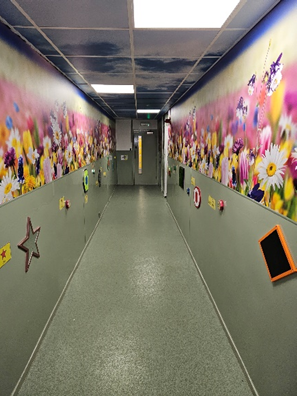Sensory Integration / Occupational Therapy

Sensory integration refers to the processing, integration, and organisation of sensory information that we receive from the body and from the environment. It is how we interpret, react to, or decide to ignore the variety of sensory input that we experience. Sensory integration enables individuals to carry out day to day tasks, and as a result, those with sensory integration or sensory processing difficulties, can experience challenges in every aspect of daily life (Sensory Help Now 2024) In order to learn effectively pupils need to be in the calm alert window and will require support to maintain this. There are 8 sensory systems that should be considered when looking at sensory integration.
The vision for sensory integration at Kingsbury is that all pupils are able to access activities and spaces that meet their sensory needs so that they can engage with learning and carry out day to day activities such as self-care, eating and social interactions. It is also important that if specific sensory needs are identified, that cannot be met within the universal offer at Kingsbury, these needs are referred to and managed by appropriate targeted or specialist interventions and professionals in a timely manner. All staff have access to training sessions that give them an understanding of sensory integration and what they can do to support pupil’s sensory needs.
Sensory Spaces at Kingsbury
Sensory circuits and equipment:
Each classroom has sensory equipment that can be used to support sensory circuits in the classroom or outdoor ‘pods’. Staff have had training on sensory circuits and how to model these for pupils.
Sensory Pod:
The sensory pod is a low arousal room that provides a quiet and relaxing ‘womb space’. For pupils who need to access calming sensory activities, the room provides auditory, visual and tactile stimuli in the form of lighting, quiet music, sound buttons and textured carpet. The space can be accessed by pupils as they need to be regulated throughout the day but also scheduled to be accessed by every class during the week. This enables adults to model the use of the room while pupils are regulated, as a proactive, preventative measure for promoting sensory and emotional regulation.

Zen Den:
The Zen Den is a retreat space that can be accessed by pupils who require a limited sensory stimuli in order to regulate. The room features a dark den, with soft flooring and cushions, where pupils can retreat if they need a break from auditory and visual stimulation. Soft seating allows an adult to supervise and model regulation techniques while also giving pupils the space to regulate in a quiet environment.

Sensory Corridor
The sensory corridor provides a multi-sensory experience for those seeking tactile, visual and auditory stimuli, as well as proprioceptive input. Buttons placed throughout the corridor provide different sounds. These buttons are placed at varying heights, so they can be used to encourage proprioceptive input through jumping and reaching, as well as the feedback from hitting the button. Additionally, tactile input is also placed throughout, with different textures available on the walls. This area ensures that a wider range of sensory needs are catered for and meets the needs of those who may not be seeking movement-based input. It is also beneficial for those who may need visual, auditory, and tactile sensory needs met as well as their proprioceptive sensory needs.

Sensory Studio:
The focus of the sensory studio is to provide alerting, organising and calming activities for pupils that can be used in a full sensory circuit, or in isolation, to meet the needs of each pupil. The equipment focusses on proprioceptive and vestibular input, as well as providing some visual and tactile input. The sensory studio features soft play equipment such as a swing and biff bags, which provide vestibular and proprioceptive input, as well as a jump and play apparatus, peanut balls, and stepping stones. This equipment is multi-purpose and can be used for alerting, organising, and calming sensory input. Modelling by adults and visuals displayed in the room will aid the understanding of how to use the equipment. Zones of regulation boards also allow adults to model this expression of emotions, allowing sensory equipment to also aid in emotional regulation.

Outdoor Learning:
Outdoor learning experiences such as Forest School and Kingsbury Gardens allow pupils to access sensory input through other aspects of their school day. Participation in forest school activities allows pupils to access’ heavy work’ such as digging, carrying and moving, which provide proprioceptive input. The use of soil, clay and arts and crafts supplies provide tactile input for pupils and allows them to explore different textures, The sensory garden provides access to water and sand play, which allows the exploration of tactile stimuli. Pupils are encouraged to explore the sounds, textures and smells of nature in a way that safely supports their sensory needs. Whilst the playground promotes play, movement and balance.

Sensory profiles
Sensory profiles make up part of the targeted support for pupils at Kingsbury Academy. They are completed by the school occupational therapist and informed by a sensory questionnaire and provide a more individualised plan of support for pupils who need more than the universal offer outlined in wellbeing passports.










